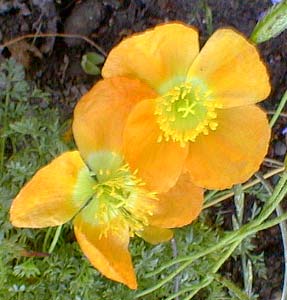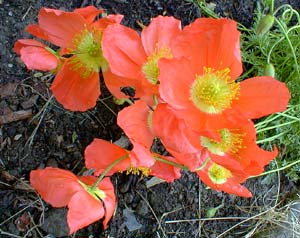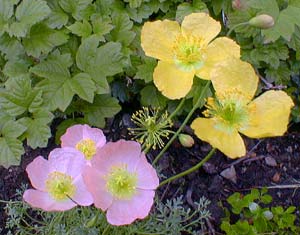
Alpine Poppies; aka
Glacier Poppies, or
Hybrid Dwarf Poppies
"Mad Patsy said, he said to me,
That every morning he could see
An angel walking on the sky;
Across the sunny skies of morn
He threw great handfuls far & nigh
Of poppy seed among the corn;
And then, he said, the angels run
To see the poppies in the sun."
-James Stephens
(1825-1901)
(1825-1901)
Alpine poppies (Papaver alpinum) are shortlived, to the point that they are often regarded as annuals or biennials. It can self-seeds, however, & in optimal conditions will return year after year.
To keep a great many of them going year after year may require occasionally adding seedlings started in coldframes or purchased in started packs, or they'll become fewer with every passing year. They can sometimes be sewn early spring right into the ground, after all danger of frost has passed, with soil kept decently moist throughout the long (three weeks) germination period.
Recommendations vary, as often it is thought to be better to start them in coldframe or greenhouse because many more of the seeds will develop than would occur in situ. On the other hand, they are difficult to transplant without lossing half of them, so starting them in their permanent locations could well be best, with perhaps a removable coldframe or tent until they are well up.
 Although it's often said they will flower their first year if started from seed early enough in spring, just as commonly they do not flower until after they've experienced one winter dormancy. One reason to start them in greenhouses, despite the losses from their susceptibility to transplant shock, is to get a headstart on spring & so improve the odds of summer blossoms the first year.
Although it's often said they will flower their first year if started from seed early enough in spring, just as commonly they do not flower until after they've experienced one winter dormancy. One reason to start them in greenhouses, despite the losses from their susceptibility to transplant shock, is to get a headstart on spring & so improve the odds of summer blossoms the first year.They are an Old World poppy native to high mountains of Central Europe, the Balkans, the Pyrannees, & other locations. The isolation of these poppy populations on mountains far distant from one another, a few even restricted to specific islands of alpine lakes, means there are a vast number of variant forms, several of which qualify as subspecies.
As commonly gardened, they are selected hybrids of color variants & subspecies. For examples, P. alpinum ssp. sendtneri is white with a yellow heart; P. alpinum ssp. kerner is bright yellow; P. alpinum ssp ernesti-mayer is white; P. alpinum ssp rhaeticum is light yellow; P. alpinum subsp. dubium is bright red; & so on. Some have one-inch flowers, some open into three-inch discs.
Modern hybrid mixes have been crossbred & crossbred so many times that they can no longer be specifically identified by anything but color. Shown on this page are salmon pink, light yellow, orange with yellow eye, & deep sun-yellow.
 Alpine gardeners may be able to get them to perennialize, & can divide clumps every other year to keep them refreshed. Without a dormant cold winter they cannot perennialize. They are nevertheless quite adaptable & though preferring life at high elevations will also flower freely at sea level.
Alpine gardeners may be able to get them to perennialize, & can divide clumps every other year to keep them refreshed. Without a dormant cold winter they cannot perennialize. They are nevertheless quite adaptable & though preferring life at high elevations will also flower freely at sea level.Temperate & cool climates are ideal & they prefer USDA zones 5 through 7, but can often be successfully stretched to zones 3 through 10, being more certainly annuals where they experience extremes. They require full sun.
These miniature poppies rarely stand taller than about eight to ten inches. The fine, slender foliage has a ferny blue-green beauty even when between re-flowerings. They flower from late spring or early summer, with rebloom possible up to autumn.
The flowers are not individually long-lasting, & are too fragile to take for bouquets, but they generate a great many blooms serially so are long present in the garden.
They can be very sensitive & not apt to self-seed & return in conditions that stress them, yet hardy when they find themselves growing in conditions they like. Too much attention will kill them, & sometimes the best results are had from ignoring them. In particular, fertilizing is a bad idea.
They don't like droughtiness & will die to the ground in a hot dry droughty month, but the root doesn't necessarily die, & a clump can return in early autumn when drought conditions improve. Yet at the same time they decline swiftly if overwatered & are especially at risk if soil drains poorly. It is sometimes recommended to place them in gravelly soil & mulch around them with stones to help maximize drainage.